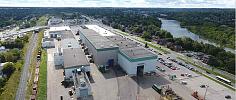- FMA
- The Fabricator
- FABTECH
- Canadian Metalworking
Tough materials continue to drive creep-feed grinding
Big removal rates with excellent accuracy and surface finish
- By Canadian Metalworking
- June 19, 2014
- Article
- Metalworking
Today’s difficult-to-process workpiece materials and complex, high-value parts have sparked resurgence in the use of continuous-dress creep-feed grinding. At the same time, the capabilities of advanced grinding machines, CNC technology, and grinding wheel materials have boosted the cost-effectiveness of the process.
As compared with traditional reciprocating grinding, creep-feed grinding provides the means to remove significant volumes of metal in a short time and still generate top accuracy and finish. While reciprocating grinding removes smaller amounts of material in multiple faster lighter passes, creep-feed grinding applies the wheel in single passes that are 0.300” or more deep and at slower feed rates.
When first put to use in the 1950s, creep-feed grinding utilized relatively soft, porous grinding wheels and flood coolant to minimize generation of heat. Although creep-feed grinding could cut cycle time by half in some cases, the process was limited in application because wheels wore quickly, restricting the length of cut possible before wheels required dressing.
CREEP-FEED: BACK TO THE FUTURE
The advent of continuous-dress creep-feed grinding in the 1970s addressed the issue of rapid wheel wear. As the name indicates, in continuous-dress creep-feed grinding machines dress wheels without interruption throughout the grinding process. A diamond dressing roll with a mirror-image form of the desired part profile maintains constant contact with the grinding wheel to keep it sharp.
Because the wheel is always sharp, long lengths of cut are possible. Plus, this consistent wheel performance results in lower average grinding forces and leads to more efficient abrasive use, shorter cycle times and increased production rates.
Creep-feed grinding can be considered abrasive or small-chip machining, capable of replacing milling or broaching in the machining of slots and complex forms in difficult-to-grind materials including prehardened tool steels and advanced alloys. Because the process completes a part in a single fixturing and in one pass, it reduces overall cycle time.
The process’ single pass generates much lower levels of heat, so thermal effects on the workpieces are minimized. The full wheel contact and slower feedrates of creep-feed grinding also dampen vibration, and surface finishes of 16 rms and better are possible.
As manufacturers seek ever-higher levels of performance, durability, and quality, they employ new manufacturing materials such as nickel-base alloys and tough cermet materials like titanium aluminide for parts such as automotive valves and turbocharger wheels. These parts are often complex in shape with thin walls, deep contours and other features that will easily distort or work harden under heat generated by traditional grinding or machining processes.
Additionally, some whisker-reinforced materials contain fibers, and the large cutting edges of milling cutters can pull them out, but the thousands of tiny cutting teeth of a grinding wheel cut them cleanly. Creep-feed grinding fills a need for an unwaveringly sharp, cool and free-cutting material-removal process.
USE THE RIGHT EQUIPMENT
According to grinding machine builders, gaining the maximum benefits of creep-feed grinding requires the use of machines and grinding wheels engineered specifically for the process. Admittedly, some shops perform a variant of creep-feed grinding involving deep passes on workpieces with narrow cross sections. Such operations are possible on standard grinding machines at somewhat reduced table speeds using conventional grinding wheels. But doing so depends on factors that include workpiece material, depth and width of the grinding pass, rigidity of the machine and nature of the grinding wheel.
True creep-feed grinding, on the other hand, maximizes the arc of contact between the wheel and part and requires use of a rigid, high-horsepower multi-axis CNC machine designed to handle the high stresses and kinetic complication of the creep-feed process.
A major source of complication is the continuous-dress process. For continuous-dress applications, a grinding machine’s basic three CNC axes are supplemented by a fourth axis controlling the infeed of the diamond dressing roll. The roll turns in the same direction of the grinding wheel and feeds into the wheel in increments of millionths of an inch per revolution, ranging from typical rates of 0.00001” to 0.00002” per revolution to steps as large as 0.00005” or 0.00006”.
As the grinding wheel’s diameter shrinks during continuous dressing, the grinding machine’s programmed wheel spindle increases rpm to maintain the surface speed required to grind the part. Likewise, a variable-speed servomotor constantly changes the dresser roll’s rpm to maintain the correct pace of dressing.
Depending on the specific application, the contact pressure on a creep-feed grinding wheel may exceed 2,000 lbs total force. The structure of a machine engineered for creep-feed operations must handle such forces and stresses, and part fixturing as well must be designed to resist these high forces too.
Horsepower well beyond that of a standard grinding machine is required for creep-feed grinding to generate and maintain the high-productivity forces needed to remove large amounts of material quickly. While a typical reciprocating grinder generates 20 hp to 50 hp, a common creep-feed grinding machine ranges from 60 hp to 150 hp and more. One benchmark dictates 20 hp for every cubic inch of material removed per minute, per inch of wheel width.
Ideal creep-feed grinding machines also sport direct drive spindles that eliminate variables such as slipping belts. The drive system for their diamond roll dressers must also possess the capability to generate and withstand high levels of torque. A servomotor drives the dressing roll into the grinding wheel to reform it, but the dressing wheel needs to hold its speed and not impart accelerative forces to the grinding wheel itself.
Creep-feed grinding requires that the workpiece be fed slowly and precisely under the wheel — in general, the greater the depth of cut, the slower the table speed. Feed control is crucial to maintain part precision and also because any sudden change in table feed can break a grinding wheel that is under heavy grinding forces, which is often the case in the creep-feed process.
Variable-speed ballscrews, racks and pinions or electromechanical table drives will maintain tight control over table speed and position. They provide this control minus any surging that might occur with table speeds as slow as 0.5 ipm, although more common speeds are in the range of 8 ipm–30 ipm. Hydrostatic or linear-bearing ways then provide preload to eliminate slack and absorb vibration for maximized grinding precision.
A variation on the continuous-dress creep-feed process, called in-process continuous-dress, can help control manufacturing costs where possible. With the in-process strategy, the continuous-dressing operation is, in fact, not continuous, but switched on and off according to need.
Based on the workpiece material, amount of stock being removed, wheel configuration, and other factors, continuous-dressing on a long cut may result in grinding wheel overdressing. And while part dimensions remain unaffected, valuable wheel material is wasted.
During the in-process dressing mode, the machine monitors its power consumption and detects any increases or surges, which would indicate a dull grinding wheel. When a rise in power usage occurs with in-process continuous-dressing, the machine initiates wheel dressing, and when consumption returns to normal, the dressing cycle stops. In the long run, such a strategy can optimize use of abrasives and save time by reducing the frequency of shutdowns for wheel changes.
NEW WHEELS, BETTER PERFORMANCE
In light of renewed interest in creep-feed grinding, wheel vendors have developed wheels that minimize wheel consumption in the continuous-dress creep-feed process. Grinding wheels engineered for creep-feed grinding applications feature open bond, “induced pore” structures.
When the wheel is buried deep in the cut, the pores provide a path for coolant, swarf and excess wheel material to escape the grinding zone. Aluminum oxide, for instance, is the most common abrasive material used in grinding wheels. New wheels designated as ceramics (actually premium-level aluminum oxide) can grind up to three times faster than conventional abrasives, according to wheel makers, while the ceramic wheels’ durability enables them to process as many as three times as many parts per wheel. The new wheels’ durability and productivity offset their required higher initial investment, wheelmakers say.
Wheel durability as well as grinding results themselves are dependent on the proper application of coolant in creep-feed grinding. Coolant prevents buildup of heat in the part and grinding wheel, and also removes swarf from the wheel contact zone to prevent marring of the workpiece. Sufficient coolant flow also prevents the pores of the grinding wheel from becoming filled with swarf, a condition that reduces the wheel’s cutting effectiveness and further reduces the coolant’s temperature-control benefit. When temperatures rise too high, the wheel may burn the workpiece and swarf may weld to the wheel, negatively affecting workpiece dimensions and finishes.
Creep-feed grinding, and in many cases its continuous-dress version, provide a variety of benefits when processing the growing selection of high-performance workpiece materials. Accuracy and repeatability are a given. The speed of creep-feed grinding boosts productivity, and the elimination of many pre-grinding and post-process operations as well as part handling can significantly reduce overall part production times. Successful application of creep-feed grinding requires investment in appropriate equipment including specialized grinding machines and grinding wheels, but for the right situations and materials, return on the investment will far exceed a creeping pace.
About the Author
subscribe now


Keep up to date with the latest news, events, and technology for all things metal from our pair of monthly magazines written specifically for Canadian manufacturers!
Start Your Free Subscription- Industry Events
MME Saskatoon
- May 28, 2024
- Saskatoon, SK Canada
CME's Health & Safety Symposium for Manufacturers
- May 29, 2024
- Mississauga, ON Canada
DiPaolo Machine Tools Open House 2024
- June 4 - 5, 2024
- Mississauga, ON Canada
FABTECH Canada
- June 11 - 13, 2024
- Toronto, ON Canada
Zoller Open House & Technology Days 2024
- June 12 - 13, 2024
- Ann Arbor, MI























